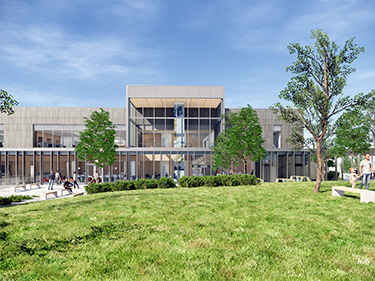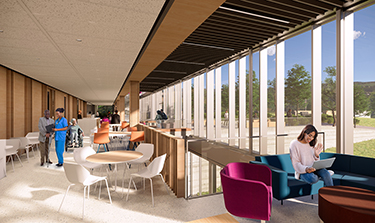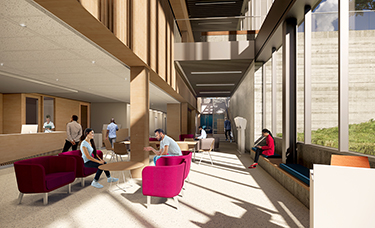|
Subscribe / Renew |
|
|
Contact Us |
|
| ► Subscribe to our Free Weekly Newsletter | |
| home | Welcome, sign in or click here to subscribe. | login |
Construction
| |
 |
April 1, 2022
A cancer care model with all the right amenities
Mahlum Architects

Bauser
|
In Southern Oregon alone, there are more 2,000 new cases of cancer diagnosed each year. To address this challenge, Asante set out to transform oncological care with the creation of the new Heimann Cancer Center, soon to be the most advanced home for cancer treatment in the region.
Consolidating all outpatient oncology services under a single roof, the nearly 80,000-square-foot Heimann Cancer Center provides medical oncology, radiation therapy, infusion therapy, imaging and lab services, patient education, cancer research and pharmacy access. The center focuses on delivering medical excellence through a value-based treatment system where patients and families come first.
The design of the new facility began with connecting Mahlum’s design team and Asante’s administrators more directly to the specific needs of cancer patients and their caregivers by creating the Cancer Champions Group — a patient advisory group comprised of 15 to 20 current patients, past patients, and caregivers/family members. The thoughtful participation of these individuals led to several key insights that shaped the architectural response:
• Importance of the caregiver. People do not make the care journey alone and the environment should support and celebrate those who make the journey with them.
• Connection to nature. We draw strength and healing from our natural world.
• Scales of community. Patients, caregivers, and care teams form community at different scales and in different ways throughout the treatment cycle.
• Sensitivity to sunlight. Patients experiencing infusion and radiation treatments can have extreme sensitivity to sunlight.
The facility’s comprehensive program was designed as a full-service facility for outpatient cancer care, making it possible for patients to combine their infusion and radiation therapy appointments with group therapy and/or educational visits without ever needing to leave the building. But this encompassing care model means that patients might spend up to five hours on site between appointments. So to capitalize on extended stays, the center provides patient amenities such as massage, yoga, nutrition, and health meeting spaces, and “sharing spaces” where volunteers connect patients with wigs, scarves, and other accessories that dignify the journey. The facility also supports extended stays with the introduction of “third spaces” which are flexibly programmed areas of respite that support relaxation, intermittent work, and/or social connections.
The lobby and circulation spaces are widened throughout, allowing patients and caregivers to continually move together, side-by-side. The multi-story, public lobby overlooks gardens on “the Knoll” and outdoor gathering spaces integrated into the natural landscape, while care was taken to ensure that the therapeutic effects of these spaces could also be enjoyed by those experiencing sensitivity to the sun. Therefore, exterior glazing is coated in a UV protective film and inboard seating provides users protection from the direct sun while maintaining clear views to the exterior.
These same concepts were extended to the infusion floors where the spatial planning allows patients to engage at different scales of community. The individual infusion bays are rotated to provide patients with privacy and direct views to nature while offering ample space for caregiver support. For those desiring greater social interaction and connection, the flexible planning enables patients to employ their ability to move during treatments to form impromptu gatherings where patients and caregivers can build community around playing games, socializing, or just enjoying one another’s company.
Perhaps the greatest insight from the Cancer Champions Group was the importance of extending design into the clinical spaces where patients can sometimes feel their most vulnerable. While state-of-the-art linear accelerators are critical to providing precision radiation treatments, the equipment and vaults can create intimidating environments. The design solution was to provide a floor-to-ceiling window at the vault entries, bringing daylight and warmth to the building interior and illuminating a 100-foot-long photographic wallcovering of the Oregon Coast. Such components welcome patients into the space, reducing some of the tension and anxiety often associated with radiation therapy treatment. Similar biophilic elements and wood materials permeate the public and clinical spaces — bringing a calming effect throughout.
In elevating the voices and perspectives of patients and caregivers through the Cancer Champions Group, Asante’s Heimann Cancer Center delivers a warm and welcoming, patient-centric environment commensurate with the excellence of the care provided. By centering the needs of those most impacted by the work, we are building healthier, enduring communities.
As the leader of Mahlum’s health care studio with 17 years of architectural experience, PJ Bauser brings a knowledge of creating healthful environments and a passion for using design to serve vulnerable populations.
Other Stories:
- A boost for health care education at Bates Tech
- Don’t ignore new compliance requirements
- Designing a healing river in Sequim
- The lab building of the future is NEXT
- What it takes to build health and science projects
- The challenge of fighting climate change Health
- It’s time to rethink health care design





